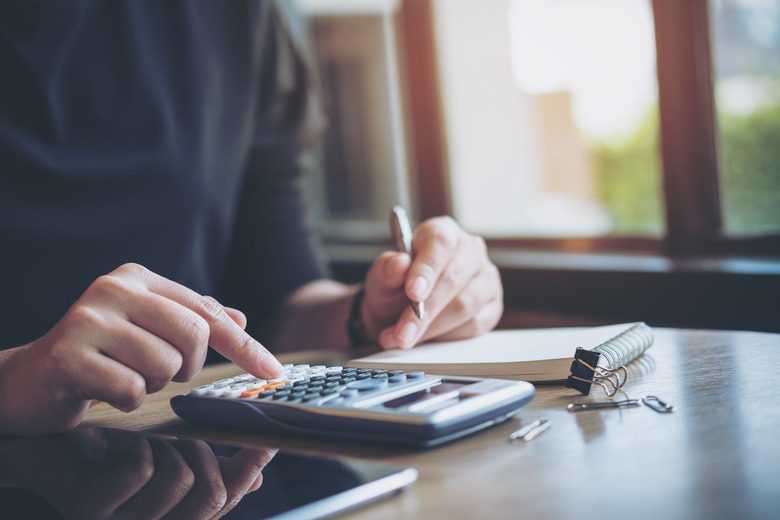How To Write Numbers In Standard Form
NASA tells us that the distance from the Earth to the nearest star is 40,208,000,000,000 kilometers. If your eyes sink into the back of your head when you see a number like that, imagine if you had to make calculations with it. Just to multiply or divide it by the speed of light, you would need a calculator so large it wouldn't fit in your hand. Scientists handle very large numbers like this one, as well as very small numbers, by converting them to standard form, which is a decimal number followed by an exponent of 10. The decimal can be accurate to as many places as desired, but it's usually rounded to two. The value of the exponent indicates the magnitude of the number. In standard form, the distance to the nearest star is a much more manageable 4.02 X 1013 km.
TL;DR (Too Long; Didn't Read)
To convert a number to standard form, place the decimal to the right of the first non-zero digit. If the entire original number is greater than 1, count the numbers that appear to the right of this decimal. The number you find by counting is the exponent. Multiply the number, now in the form of the first digit, decimal point, and next two digits, by 10 raised to this exponent. If the number is less than 1, count the numbers to the left of the decimal and multiply by 10 to a negative exponent of the number you counted.
Groups of Three
Groups of Three
Before converting a number to one containing an exponent, remember another convention, which is to split number strings into groups of three – or thousands – with commas. For example, the number 10835921 is usually written 108,359,921. The first three digits in a number are the ones that appear when you express the number in standard form. This is true even if the first group contains only one or two digits. For example, the first three digits of the number 12,315,428 are 1, 2 and 3.
Positive and Negative Exponents
Positive and Negative Exponents
Very small numbers, such as the radius of an atom, can be just as unwieldy as very large ones. You use the same strategy to convert either to standard form. If the number is large, you set the decimal after the first digit on the left, and you make the exponent positive. It equals the number of digits that follow the decimal. If the number is very small, the first three digits that appear after the string of zeros are the three you use at the beginning of the number in standard form, and the exponent is negative. The exponent equals the number of zeros plus the first digit in the number series.
**Examples:** The speed of light is 299,792,458 meters/second. In standard form, this is 3.00 X 108 m/s. (Note that you have to round 299 to 300 because the fourth digit is larger than 4). The distance between the nucleus and electron of a hydrogen atom is 0.00000000005291772 meters. In standard form, this is 5.29 X 10-11 meters. (You don't have to round up, because the digit following 9 in the original number is less than 5).
Arithmetic With Numbers in Standard Form
Arithmetic With Numbers in Standard Form
**Addition and Subtraction:** It's easy to add and subtract numbers in standard form, as long as they have the same exponents. You simply add or subtract the strings of digits. If the numbers have different exponents, convert one of them to the exponent of the other.
**Example:**
Add 3.45 X 1010 and 2.75 X 108. The first number is the same as 345 X 108. Note how as the decimal point moves, the exponent changes. Adding them, we get 347.75 X 108 or – less accurately – 3.48 X 1010.
Add 4.00 X 1012 and 7.55 X 1012. The answer is 11.55 X 1012 or 1.16 X 10 13.
**Multiplication and Division:** When you multiply numbers in standard form, you multiply the strings of numbers and add the exponents. When you divide one number by the other, you perform the division operation on the number strings and subtract the exponents.
**Examples:**
Multiply 3.25 X 108 by 1.42 X 104. The answer is 4.62 X 1012.
Divide 3.25 X 108 by 1.42 X 104. The answer is 2.29 X 104.
Cite This Article
MLA
Deziel, Chris. "How To Write Numbers In Standard Form" sciencing.com, https://www.sciencing.com/write-numbers-standard-form-6561983/. 26 April 2018.
APA
Deziel, Chris. (2018, April 26). How To Write Numbers In Standard Form. sciencing.com. Retrieved from https://www.sciencing.com/write-numbers-standard-form-6561983/
Chicago
Deziel, Chris. How To Write Numbers In Standard Form last modified August 30, 2022. https://www.sciencing.com/write-numbers-standard-form-6561983/
